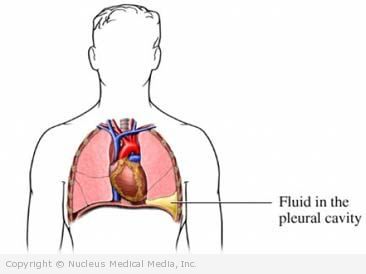Pleural effusion
(Water on the Lungs)
Pleural effusion – Definition
The pleura are two thin, moist membranes around the lungs. The inner layer is attached to the lungs. The outer layer is attached to the ribs. Pleural effusion is the buildup of excess fluid in the space between the pleura. The fluid prevents the lungs from fully expanding. This causes shortness of breath. There are two types of effusion:
- Transudative
- Exudative
Pleural effusion – Causes
Effusion is usually caused by disease or injury. The two types have different causes:
Causes of Transudative Effusion
- Heart failure
- Malnutrition
- Liver disease
- Kidney disease
- A large shift in body fluids, such as during childbirth
- Presence of a tumor
Causes of Exudative Effusion
- Tuberculosis
- Pneumonia and other lung infections
- Cancer, especially of the lung, breast, or lymph system
- Rheumatic disease, such as sarcoidosis
- Drug reactions
Pleural effusion – Risk Factors
Factors that increase your chance of getting pleural effusion include:
- Pneumonia, tuberculosis, or other lung diseases
- Heart attack, heart failure, or infections such as pericarditis, recent cardiac surgery
- Inflammation or infection of the pleura
- Liver disease
- Tumors
- Pregnancy, recent delivery
- Connective tissue diseases, such as rheumatoid arthritis and lupus
- Certain medicines:
- Nitrofurantoin (Macrodantin, Furadantin, Macrobid)
- Dantrolene (Dantrium)
- Methysergide (Sansert)
- Bromocriptine (Parlodel)
- Procarbazine (Matulane)
- Amiodarone (Cordarone)
- Cancers, such as lung, breast, lymphoma, or mesothelioma
- Chest injury or trauma
- Radiation therapy
- Pulmonary embolus (blood clot in the lungs)
- Abdominal infections or pancreatitis
- Surgery, especially involving
- Heart
- Lungs
- Abdomen
- Organ transplantation
Pleural effusion – Symptoms
Some types of pleural effusion do not cause symptoms. Others cause a variety of symptoms, including:
- Shortness of breath
- Chest pain
- Stomach discomfort
- Cough
- Coughing up blood
- Shallow breathing
- Rapid pulse or breathing rate
- Weight loss
- Fever, chills, or sweating
- Hiccupping
Pleural effusion – Diagnosis
The doctor will ask about your symptoms and medical history. A physical exam will be done. This may include listening to or tapping on your chest.
Tests may include:
- Chest x-ray — a test that uses radiation to take a picture of structures inside the chest
- Ultrasound — a test that uses sound waves to find or examine structures inside the chest
- Computed tomography (CT) scan — a type of x-ray that uses a computer to make pictures of structures in the chest
- Thoracentesis — fluid sample extracted from the pleural space around the lungs with a needle
- Pulmonary function tests — to check breathing ability
- Biopsy — removal of a sample of pleural tissue for testing
- Thoracoscopy— a thorascope (a tool with a tiny camera) is inserted into the chest to allow the doctor to view the chest space on a monitor
Pleural effusion – Treatment
Treatment is usually aimed at treating the underlying cause. This may include treating:
- Heart failure
- Blood clots in the lungs
- Infection by administering antibiotics
If you are not having any symptoms and the effusion is small, your doctor may take a “watchful waiting” approach and monitor your condition.
To Support Breathing
If breathing is impaired you may receive:
- Breathing treatments
- Supplemental oxygen
Drain the Pleural Effusion
The pleural effusion may be drained by:
- Therapeutic thoracentesis — done by inserting a needle into the area and withdrawing fluid
- Tube thoracostomy — inserting a chest tube into the side of your chest and leaving it in place for several days, eventually attached to suction
Seal the Pleural Layers
In some cases, the doctor may recommend chemical pleurodesis. During this procedure, talc powder or an irritating chemical is injected into the pleural space. This will permanently seal the two layers of the pleura together. This may help prevent further fluid buildup.
Radiation therapy may also be used to achieve this purpose.
Surgery
In severe cases, surgery may be needed. It is done to remove some of the pleura and resolve the pleural effusion. This may be accomplished through:
- Thoracotomy — traditional, open chest procedure
- Video-assisted thorascopic surgery (VATS) — minimally-invasive type of keyhole surgery
Pleural effusion – Prevention
The best way to prevent pleural effusion is to get prompt treatment for any condition that may lead to it.

